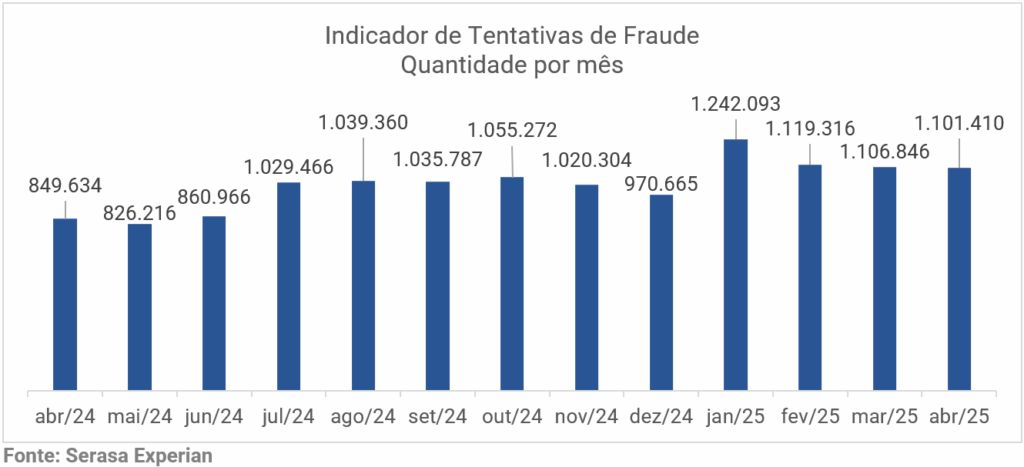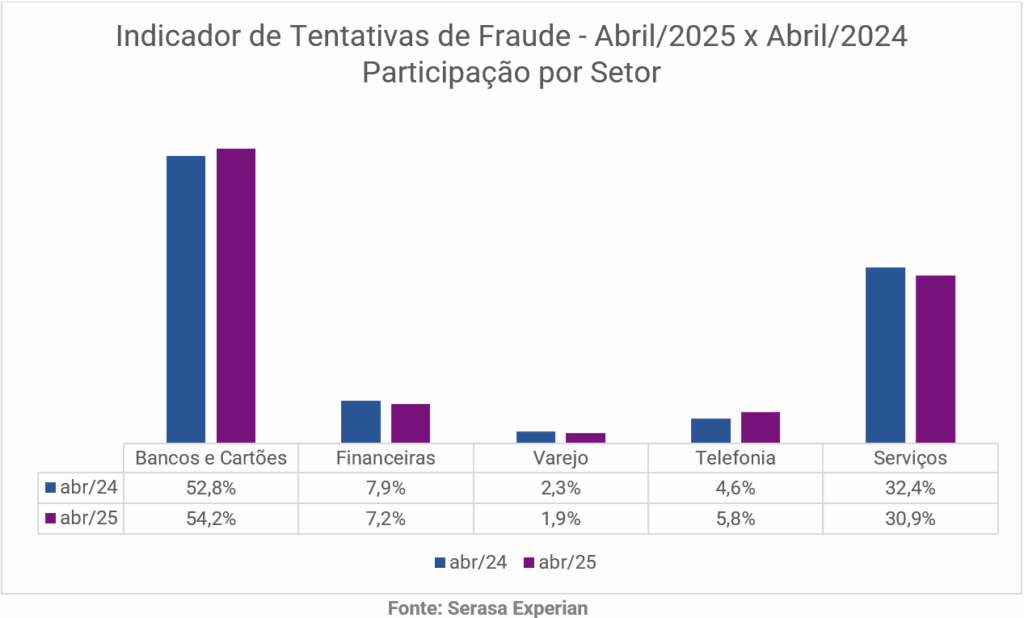Fraud in Brazil is targeting a new group: young people. According to the Fraud Attempt Indicator from Serasa Experian, the first and largest datatech company in Brazil, the number of scams targeting people up to 25 years old grew by 50.2% in April 2025, compared to the same period last year. This shift in criminals' focus reveals a dynamic in attack strategies targeting highly connected profiles with less financial history. The survey also indicates that the country registered 1,101,410 attempted frauds in the month, equivalent to one every 2.4 seconds—a volume that has remained above 1 million since January.
“In general, fraud attempts continue to evolve rapidly, driven by technologies such as artificial intelligence and the sophistication of social engineering tactics. It's no longer just about volume, but also the quality of the scams,” highlights Caio Rocha, Director of Authentication and Fraud Prevention at Serasa Experian. “In this scenario, the adoption of layered anti-fraud strategies is indispensable. Integrated solutions that operate at different stages of the digital journey allow for more precise identification of suspicious behavior and proactive action, reducing risks before fraud even occurs. Furthermore, it is essential to promote continuous awareness among consumers, who continue to be targets of scammers,” he adds.
Check out the chart below showing the monthly evolution of attempted fraud over the last 12 months:

Economically active adults continued to be the main target of scammers. In April, the 36-50 age group was the most affected by fraud attempts, accounting for a third (33%) of detected incidents. This was followed by the 26-35 age group (26.3%) and those under 25 (15%).
However, when compared to April 2024, the largest proportional growth was recorded among younger people: the participation of victims up to 25 years old increased by 50.2%, revealing a worrying trend of expanding the reach of fraud among people with less credit history or less prior exposure. The 26-35 and 36-50 age groups also showed significant increases, of 38.2% and 26.8%, respectively.
“The significant growth of fraud among younger people raises an important alarm. This group, often with little credit history and less familiarity with digital traps, has become a new strategic target for fraudsters. It is essential that fraud protection begins early, with access to information and digital education, as well as monitoring tools and constant review of processes at each stage of the journey by companies, in order to guarantee layered protection throughout the entire process, from customer registration to purchase,” says Caio Rocha, Director of Authentication and Fraud Prevention at Serasa Experian.
Among older audiences, participation in the 51-60 age group grew by 21.1%, while the group over 60 years old saw an increase of 11.7% during the period, reinforcing that, although with a smaller total volume, fraudsters continue to target profiles that are more vulnerable in terms of digital experience or access to information.
Banks remain the primary target of scammers, but the telecommunications sector led in annual growth.
The Banking and Credit Card sector continued to lead the ranking of attempted fraud in Brazil, accounting for 54.2% of reports in April 2025. This was followed by the Services sector (30.9%), Finance (7.2%), Telecommunications (5.8%), and Retail (1.9%).

All segments registered an increase compared to April 2024, with the Telephony sector standing out, showing the largest jump: a 61.1% increase in attempted fraud. Following this, Banks and Cards grew by 32.9%, while Services saw a 23.9% increase. Financial institutions and Retail showed increases of 19% and 9.5%, respectively.
Fraud involving manipulated data during registration accounts for more than half of the attempts prevented.
In the analysis by type, most of the fraudulent attempts were identified due to registration inconsistencies (52.1%) identified in April 2025. This type includes discrepancies in personal data provided at the time of registration, such as CPF (Brazilian taxpayer ID), name, address, or telephone number, which do not match reliable sources or show signs of manipulation.
Alerts related to document authenticity and biometric verification, responsible for 39.9% of the attempts prevented, came in second place. Finally, suspicious behavior on devices, such as access from equipment linked to previous fraud attempts or anomalous browsing patterns, accounted for 8% of the frauds blocked during the period.
The Southeast region accounts for almost half of the fraud cases, but the North leads in proportional growth.
The Southeast region continued to be the epicenter of attempted fraud in the country, with 521,451 occurrences in April 2025, representing 47.3% of the national total. The ranking continued with the Northeast (246,550), South (177,351), North (79,431), and Central-West (76,627). Despite this, when observing the annual variation by region, the North led the proportional increase, with a 38.3% rise in attempted fraud compared to the same month of the previous year. The Northeast also showed strong growth (+33.7%), with states such as Amazonas (+42.2%), Pará (+41.4%), and Maranhão (+38.9%) standing out.
The state of São Paulo led by a wide margin in the monthly number of registrations, with 301,195 occurrences, followed by Rio de Janeiro (104,117) and Minas Gerais (96,161). At the other end, Roraima (2,290) and Amapá (3,176) presented the lowest absolute volumes, although both registered significant increases compared to April 2024, of 39.3% and 36.1%, respectively.
Despite already having high volumes, the Southeast (+29.9%) and Midwest (+27.3%) regions also registered significant growth. The South region, although having the lowest variation rates, still showed an increase of 23.1%, with Paraná standing out, totaling more than 70,000 occurrences in the month.
See below a graph showing the number of attempted fraud cases by state, followed by a table showing the annual variation:


In the analysis proportional to the population, the Federal District presented the highest rate of attempted fraud in April 2025, with 7,759 occurrences per million inhabitants. Following this, the states of São Paulo (6,540), Mato Grosso (6,093), and Rio de Janeiro (6,045) stand out, all above the national average of 5,166, and with a strong digital presence and high banking penetration, factors that increase exposure to risk.
At the other end of the spectrum, Maranhão (3,105), Roraima (3,123), and Piauí (3,361) registered the lowest densities, although some of these states showed significant increases in the annual comparison, indicating a possible trend of fraud spreading to the interior of the country. Check out the graph with complete density information by state:



